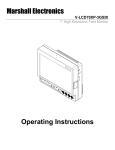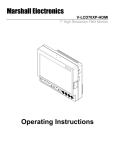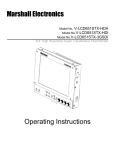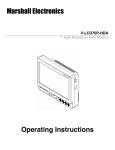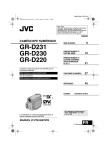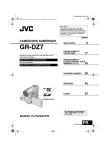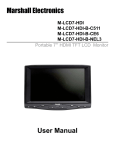Download Marshall Electronics V-LCD70XHB-3GSDI Operating instructions
Transcript
Marshall Electronics Model No. V-LCD70XHB-HDA Model No.V-LCD70XHB-HDMIPT Model No.V-LCD70XHB-3GSDI 7” Portable Field / Camera-Top Monitor Operating Instructions Marshall Electronics, Inc. 1910 East Maple Ave. El Segundo, CA 90245 Tel: (800) 800-6608 / (310) 333-0606 • Fax: 310-333-0688 www.LCDRacks.com • [email protected] 511v2 28 1 Maintenance ■ Screen Cleaning Periodically clean the screen surface using ammonia-free cleaning wipes (Marshall Part No. V-HWP-K). A clean microfiber cloth can also be used using only non-abrasive and ammonia-free cleaning agents. Do not use paper towels. Paper towel fibers are coarse and may scratch the surface of the polycarbonate faceplate or leave streaks on the surface. Antistatic and fingerprint resistant cleaning agents are recommended. Do not apply excessive pressure to the screen to avoid damaging the LCD. ■ Faceplate Dusting Dust the unit with a soft, damp cloth or chamois. Dry or abrasive cloths may cause electrostatic charge on the surface, attracting dust particles. Neutralize static electricity effects by using the recommended cleaning and polishing practice. Warranty Marshall Electronics warranties to the first consumer that this V-LCD70XHB series LCD monitor will, under normal use, be free from defects in workmanship and materials, when received in its original container, for a period of one year from the purchase date. This warranty is extended to the first consumer only, and proof of purchase is necessary to honor the warranty. If there is no proof of purchase provided with a warranty claim, Marshall Electronics reserves the right not to honor the warranty set forth above. Therefore, labor and parts may be charged to the consumer. This warranty does not apply to the product exterior or cosmetics. Misuse, abnormal handling, alterations or modifications in design or construction void this warranty. It is considered normal for a minimal amount of pixels, not to exceed three, to fail on the periphery of the display active viewing area. Marshall Electronics reserves the option to refuse service for display pixel failure if deemed unobtrusive to effective use of the monitor by our technicians. No sales personnel of the seller or any other person is authorized to make any warranties other than those described above, or to extend the duration of any warranties on behalf of Marshall Electronics, beyond the time period described above. Due to constant effort to improve products and product features, specifications may change without notice. 2 27 Dimensions Contents Installation and Initial Setup ................................................................................................................................................ 4 Front and Side Monitor Features......................................................................................................................................... 6 Rear Monitor Features .......................................................................................................................................................... 7 Compatible Input Formats.................................................................................................................................................... 8 Menu Overview ...................................................................................................................................................................... 9 Main Menu and Navigation................................................................................................................................................. 11 Video Configuration Submenu ...................................................................................................................................... 11 Marker Configuration Submenu .................................................................................................................................... 16 Filter Configuration Submenu ....................................................................................................................................... 19 System Configuration Submenu ................................................................................................................................... 20 Function Presets Submenu ........................................................................................................................................... 23 System Information Submenu....................................................................................................................................... 24 Specifications ...................................................................................................................................................................... 25 Dimensions .......................................................................................................................................................................... 26 Maintenance......................................................................................................................................................................... 27 Warranty............................................................................................................................................................................... 27 26 3 Installation and Initial Setup ■ Specifications Unpacking Carefully unpack the V-LCD70XHB monitor and verify that the following items are included: Power Input 4-Pin Male XLR ■ PANEL Screen Size Display Area (h x v) Aspect Ratio Pixels Color Depth Viewing Angle (h x v) Brightness Contrast Ratio Pixel Pitch (h x v) • V-LCD70XHB Monitor • V-PS12-5V-XLR Power Supply with 4-Pin Female XLR Connector • Operating Instructions Inspect the unit for any physical damage that may have occurred during shipping. Should there be any damage, immediately call Marshall Electronics Customer Service at (800) 800-6608. If you are not located within the continental United States, call +1 (310) 333-0606. 7.0” Diagonal 152.4 x 91.44 mm 15:9 (16:9 / 4:3 Selectable) 800 x 480 6-bit (262,114 Colors) 170° x 170° 2 800 cd/m 600:1 0.1905 x 0.1905 mm Pin 1: Pin 2: Pin 3: Pin 4: ■ ELECTRICAL Power Consumption 1.20 Amp @ 12VDC (14W Max) Voltage Requirement 12V DC (7.5V DC-18V DC) V-PS12-5V-XLR Power Supply: Input 100V-240V, 1.5A, 50-60Hz Output 12VDC, 5A, 60W Max ■ CONNECTORS Video Input Video YPBPR 1 x BNC Female (75 Ω) 3 x BNC Female (75 Ω) HDMI Input HDMI 1 x HDMI (Type A) Female ■ BATTERY ADAPTER Field-Interchangeable Battery Adapter Options (Sold Separately): 3G-SDI Video Input 1 x BNC Female (75 Ω) HDMI Output HDMI 1 x HDMI (Type A) Female 3G-SDI Video Output 1 x BNC Female (75 Ω) Note: The HDMIPT module will NOT pass through HDCP protected content. Also, the HDMIPT module will NOT pass through EDID information. Video Output (Active Loop-Through) Video 1 x BNC Female (75 Ω) YPBPR 3 x BNC Female (75 Ω) 3G-SDI 1 x BNC Female (75 Ω) GND N/C N/C +12VDC Marshall Adapter Battery Type CM Canon PM JM Battery Voltage Recommended Battery 7.4 V Canon BP-970G Panasonic 7.2 V Panasonic CGA-D54 JVC 7.2 V JVC BN-V438U SB Sony BP 14.4 V Sony BP-460 SM Sony NP-Q 7.2 V Sony NP-QM91 SL Sony NP-F 7.2 V Sony NP-F970 IDX V-Mount 14.4 V IDX E7S AB Anton Bauer 14.4 V Anton Bauer Hytron 50 ■ MECHANICAL Dimensions (w x h x d): 7.03” x 5.67” x 2.17” Additional Mounting: ¼”-20 Mounting Bracket Weight (Monitor Only): 1.60 lbs Operating Temperature 32° F to 95° F (0° C to 35° C) Storage Temperature -14° F to140° F (-10° C to 60° C) RoHs Do not dispose. Return to Manufacturer or Authorized Recycle Facility . 4 25 System Information Submenu System Information System Keypad Module (3GSDI) \ V3.xx vx.xx vx.xx System Information Submenu ■ System This shows the System firmware version of your monitor. ■ Keypad This shows the Keypad firmware version of your monitor. ■ Module This shows your module version (HDMIPT or 3GSDI) and the firmware version of your module. 24 5 Front and Side Monitor Features ■ SDI Signal Strength (V-LCD70XHB-3GSDI Model Only with 3GSDI-CLI module) Use this setting to enable an on screen indicator of your current SDI signal strength. Although this is not meant to be an absolute measurement of your SDI Signal Strength, this feature can be useful in determining the stability of the digital data along your cable run. Function Presets Submenu Function Presets Function on F1 Function on F2 Function on F3 Function on F4 Ratio Center Marker Pixel-to-Pixel Aspect Markers Function Presets Submenu ■ User-Definable Function Buttons Power Button Use the power button to toggle between ON and STANDBY modes. In the STANDBY state, the LED on the button will illuminate bright green. In the ON state, the LED will dimly illuminate green. Input Select Buttons Use the Input select buttons to select VIDEO, YPbPr, and HDMI or 3GSDI inputs. In the case of the V-LCD70XHB-HDA monitor, the third button will not be available. Video standards and formats (NTSC/PAL, etc.) are automatically detected. User-Definable Function Buttons Four user-definable function buttons can be used for direct access to various settings. Functions are assigned using the on-screen menu. Menu Navigation Buttons Use the Menu, ▲, ▼, and Select buttons to display and navigate the on-screen menu. Image Adjustment Knobs Use the image adjustment knobs to adjust brightness, color saturation, and contrast of the image. The status of each image adjustment 6 parameter is shown on the bottom left of the screen, with values ranging from 0 to 100. Default value is 50. Tint will adjust the hue of Composite inputs only. Use the Function on F1, F2, F3 and F4 menu items to define each function button on the front panel of the monitor. The following options are available for each button: • Ratio • Check Field • HDMI DSL Ratio • Horizon Indicator* • Image Flip • Mosquito Filter • Peaking Filter • False Colors • Freeze Input • Aspect Markers • Center Marker • Marker Enable • Underscan • H/V Delay • Pixel-to-Pixel Power Switch Use the hard power switch to supply power to the monitor, and choose the input from which the monitor draws power. The upper switch position uses the battery adapter, the lower switch position uses the 4-Pin XLR input, and the center position is OFF. Battery life can be preserved by setting this switch to the OFF position when the monitor is not in use. Accessory / Service Connector This connector is for Marshall Electronics’ line of VLCD accessories and for monitor service. Please contact Marshall Electronics for more information. Mounting Plate Attachment Area Use the Mounting Plate Attachment area to attach mounting brackets with ¼-20 mounting holes. This attachment area is available on the top and sides of the monitor as well. . 23 Rear Monitor Features Use the 16:9 option to scale the HDMI DSLR video output to fit the 16:9 portion of the screen. This will also remove the portion of the on screen video that is NOT recorded by the DSLR camera due to sensor crop. Use the Full Screen to Component and Composite Input and Output The V-LCD70XHB has HD component (YPbPr), composite as well as active loop-through outputs for each analog input. See page 8 for supported video formats. The BNC inputs are internally terminated with 75 ohms. Module Slot This area is intended for the Marshall Electronics’ VLCD70XHB modules, which are factory installed. . V-LCD70XHB-HDMIPT Power Input Connect 12VDC to the 4-Pin XLR power input connector. Power can be supplied from the included power supply, or from a variety of DC sources supplying at least 1 Amp at 12 Volts. IMPORTANT: If using a power source other than the included power supply, be sure that the polarity of the DC input is correct: Pin 1: Pin 2: Pin 3: Pin 4: GND N/C N/C +12VDC Battery Adapter The V-LCD70XHB can be powered from a variety of batteries. Several user-interchangeable battery adapters are available. V-LCD70XHB-3GSDI 22 ¼-20 Mounting Hole Use the ¼-20 mounting hole to attach the monitor to a camera or variety of mounting devices. 7 Compatible Input Formats The following standards are supported by the V-LCD70XHB monitors: Composite (CVBS) NTSC, PAL Component (YPbPr) 480i60, 576i50 720p (30, 29.97, 25) 720p ( 60 / 59.94 / 50) 1080p (30, 29.97, 25, 24, 24 sF, 23.98, 23.98 sF) 1080i (60 / 59.94 / 50) 3GSDI and HDMIPT Inputs V-LCD70XHB-3GSDI – V-LCD70XHB monitor with Triple-Rate SDI Input / Output SD-SDI – 480i 59.94, 576i 50 HD-SDI – 720p (60 / 59.94 / 50 / 30 / 29.97 / 25) 1080i (60 / 59.94 / 50) 1080p (30 / 29.97/ 25 / 24 / 24sF/ 23.98 / 23.98sF) 3G-SDI – YCbCr (4:2:2) 10 Bit – Level A and B 1080p (60 / 59.94 / 50) YCbCr/RGB (4:4:4) 10 Bit – Level A and B 1080i (60 / 59.94 / 50) 1080p (30 / 29.97 / 29.97sF / 25 / 25sF / 24 / 24sF / 23.98 / 23.98sF) YCbCr+A / RGB+A (4:4:4) 10 Bit 1080i (60 / 59.94 / 50) 1080p (30 / 29.97 / 29.97sF / 25 / 25sF / 24 / 24sF / 23.98 / 23.98sF) V-LCD70XHB-HDMIPT – V-LCD70XHB monitor with HDMI Input and Pass Through HDMI Video– 480p 59.94 , 576p 50 720p (60 / 59.94 / 50 / 30 / 29.97 / 25) 1080i (60 / 59.94 / 50) 1080p (30 / 29.97/ 25 / 24 / 24sF/ 23.98 / 23.98sF) ■ Contrast / Backlight Use this feature to choose between controlling the Contrast of the image or the intensity of the panel’s Backlight with the CONTRAST knob on your monitor. Note: While the Contrast control moves up and down at intervals of 1, the Backlight control will move up and down at intervals of 2, from 0-100. ■ Freeze Input Use the Freeze function to “freeze” the current image on the screen. Select this menu item again (Unfreeze) to return to the real-time video input. ■ Image Flip Use the Image Flip function to turn the monitor’s display 180°. Note: Both the image and all menus and On Screen Display text will be flipped. ■ Manufacturer Default Select this menu item to reset all adjustments and menu settings to the factory default configuration. ■ HDMI Color Space (HDMIPT Model Only) Use this setting to automatically detect (Auto) or select the color space (RGB or YCrCb) of incoming HDMI video. This should match the color space of the video output settings on your playback device. Note that this option is disabled when viewing VESA (Computer) formats. ■ HDMI Aspect Ratio ( HDMIPT Model Only) Use this setting to automatically detect (Auto) the proper Aspect Ratio settings of incoming HDMI video. Most HD signals will display in the 16:9 aspect ratio. SD signals (480P/576P) will display in the 4:3 aspect ratio. ■ HDMI DSLR Ratio (HDMIPT Model Only) During video recording, the most popular DSLR cameras place “pillar” boxes around the image when outputting to an external HDMI video sink. The HDMI DSLR Ratio option allows you to size the scale of the image so that you can see only video in the appropriate aspect ratio or only video that is being captured by the camera’s sensor. Sensor Cropped image “Pillar” Box VESA – 640 x 480 (60 Hz / 72 Hz / 75 Hz) 800 x 600 (56 Hz / 60 Hz / 72 Hz / 75 Hz) 1024 x 768 (60 Hz / 70 Hz / 75 Hz) 1280 x 1024 (60 Hz / 75 Hz) DSLR Video Note: The HDMIPT module will NOT pass through HDCP protected content. Also, the HDMIPT module will NOT pass through EDID information. DSLR HDMI Video output during recording The HDMI DSLR Ratio provides you with 3 options: 3:2, 16:9 and Full Screen. Use the 3:2 option to scale the HDMI DSLR video output to fit the screen vertically. 8 21 Menu Overview The Peaking Filter is used to aid the camera operator in obtaining the sharpest possible picture. When activated, all color will be removed from the display and a black-and-white image will remain. The internal processor will display RED color on the screen where sharp edges appear. When the camera operator adjusts (racks) the focus control (on the camera lens), different parts of the image will have RED colored edges. This indicates that the portion of the image is sharp – or in focus. Final focus is achieved by racking the camera lens focus control back and forth until the desired portion of the image has RED colored edges. Please note that this feature is most effective when the subject is properly exposed and contains enough contrast to be processed. ■ Mosquito Filter v3.51 Video Configuration ■ Peaking Filter (Focus assist) User, Linear, D55, D65, D93 1.6, 1.8, 2.0, 2.2, 2.4 H/V Delay Use this setting to filter out “Mosquito Noise” – an artifact that appears as specs around edges of objects. This artifact is the result of video that has been compressed at some point. Video sources from DVD-Players, PDA’s, Digital Cable Boxes, Camcorders, etc. often have this artifact. Marker Configuration Underscan NTSC Black Level 1 R,G,B Bias (0-100) / R,G,B Gain (0-100) Off, Mono, Blue, Green, Red Full Screen, 4:3, 16:9 Off, Centered, User Off, H & V Delay, V Delay, H Delay Off, On 0 IRE, 7.5 IRE Marker Enable Center Marker Off, On Off, On 16: 9 Markers Off, 4:3, 13:9, 14:9, 1.85:1, 2.35:1, 95% Safe, 93% Safe, 90% Safe, 88% Safe, 85% Safe, 80% Safe, User Full Screen Markers Off, 95% Safe, 93% Safe, 90% Safe, 88% Safe, 85% Safe, 80% Safe, User 4:3 Markers Off, 95% Safe, 93% Safe, 90% Safe, 88% Safe, 85% Safe, 80% Safe, User False Colors Off, On Peaking Filter Off, On Mosquito Filter Off, On System Configuration Submenu ■ Input Format OSD Use this option to enable on-screen display of input/format status in the upper-left corner of the screen. ■ Curtain Color Filter Configuration 2 System Configuration Submenu Color Temperature Gamma Correction RGB Bias and Gain Check Field Ratio Pixel to Pixel 1 2 Feature enabled in Composite NTSC Video only The False Color and Peaking Filter cannot be activated simultaneously Use this option to change the curtain color on the monitor. This curtain color is what you see when there is no signal input to the monitor. ■ Splash Screen Use this option to enable or disable the Marshall Electronics Inc. splash screen seen when the monitor is first powered on. 20 9 System Configuration Filter Configuration Submenu Input Format OSD On, Off, 5 sec Curtain Color Blue, Green, Black Splash Screen On, Off Contrast/Backlight Contrast, Backlight Freeze Input Image Flip Manufacturer Default HDMI Color Space HDMI Aspect Ratio HDMI DSLR Ratio Off, On Off, On Function Presets 5 SDI Signal Strength ■ False Colors The V-LCD70XHB has a false color filter to aid in the setting of camera exposure. As the camera Iris is adjusted, elements of the image will change color based on the luminance or brightness values. This enables proper exposure to be achieved without the use of costly, complicated external equipment. To best utilize this feature, you must understand the color chart below and have a basic understanding of camera exposure. Normally, when shooting subjects like people, it is common practice to set exposure of faces to the equivalent of approximately 56 IRE. The false color filter will show this area as the color PINK on the monitor. Therefore, as you increase exposure (open the IRIS), your subject will change color as indicated on the chart: PINK, then GREY, then a few shades of YELLOW. Over exposed subjects (above 101 IRE) on the monitor will be shown as RED. In addition, underexposed subjects will show as DEEP-BLUE to DARK–BLUE, with clipped-blacks indicated with a FUCHSIA-like color. Lastly, the color GREEN is used to indicate elements of the image that are approximately 45 IRE. This represents a ‘neutral’ or ‘mid-level’ exposure commonly used for objects (not people). 3 Auto, YCbCr, RGB 3 Auto, Manual 3 Off, 3:2, 16:9, Full Screen 4 Off, 5 sec, On Function on F1 Ratio, Check Field, HDMI DSLR Ratio, Horizon Indicator, Image Flip, Mosquito Filter, Peaking Filter, False Colors, Freeze Input, Aspect Markers, Center Marker, Marker Enable, Underscan, H/V Delay, Pixel-to-Pixel Function on F2 Ratio, Check Field, HDMI DSLR Ratio, Horizon Indicator, Image Flip, Mosquito Filter, Peaking Filter, False Colors, Freeze Input, Aspect Markers, Center Marker, Marker Enable, Underscan, H/V Delay, Pixel-to-Pixel Function on F3 Ratio, Check Field, HDMI DSLR Ratio, Horizon Indicator, Image Flip, Mosquito Filter, Peaking Filter, False Colors, Freeze Input, Aspect Markers, Center Marker, Marker Enable, Underscan, H/V Delay, Pixel-to-Pixel Function on F4 Ratio, Check Field, HDMI DSLR Ratio, Horizon Indicator, Image Flip, Mosquito Filter, Peaking Filter, False Colors, Freeze Input, Aspect Markers, Center Marker, Marker Enable, Underscan, H/V Delay, Pixel-to-Pixel False Color Key 3 Feature enabled for HDMIPT models only 4 Feature enabled for 3GSDI model only 5 Horizon Indicator option is only applicable when you have the V-LCD-HI accessory connected to your monitor 10 19 2. Use the BRIGHT, COLOR, TINT and CONTRAST knobs to move the LEFT, RIGHT, TOP and BOTTOM borders of the safe area to your desired position. When you have reached the desired location for the borders, press the MENU button. If you began the marker adjustment using one of the predefined safe areas and made an adjustment, the marker selection will automatically convert to the User marker setting. Main Menu and Navigation Main Menu Access the main menu by pushing and holding the MENU button on the front panel of the monitor. •Step through menu items using the ▲ and ▼ buttons. •Choose a submenu or select a menu item by pressing SELECT. •Return to the previous menu by pressing MENU. •Exit the main menu by pressing MENU. The menu will automatically time out after 15 seconds. ■ Marker Background Use this setting to choose how selected markers are displayed on the screen. : • • • • • 0% 25% 50% 75% 100% Video Configuration Submenu The marker is superimposed on the complete image. Image area beyond the marker is shown at 25% intensity. Image area beyond the marker is shown at 50% intensity. Image area beyond the marker is shown at 75% intensity. Image area beyond the marker is shown at 100% intensity (black). Example (80% Marker in 4:3 Mode): Video Configuration Submenu Normal Background Black Background ■ Color Temperature Use this setting to choose one of three color temperature presets: • • • • • D55 (5500K) D65 (6500K) D93 (9300K) USER (Adjustable Color Bias and Gain) Linear (No processing is applied to the panel) ■ Gamma Correction Use the Gamma Correction setting to adjust the value of the gamma applied to incoming video signals. The default gamma value is 2.2. Gamma correction represents the relationship between the pixel levels from your incoming video 18 11 and the luminance of your monitor. The lowest gamma level available, 1.6, will cause the image to appear brighter. The highest gamma level available, 2.4, will cause the image to appear darker. The chart below shows this on a scale. Gamma Correction ■ Full Screen Markers Use this setting to superimpose one of 7 markers on the screen when in Full Screen mode. This setting is disabled when the aspect ratio is set to 16:9 or 4:3, or when Pixel-to-Pixel, Underscan, or H/V Delay is enabled. 1 0.9 • • • • • • • Pixel Value Luminance 0.8 0.7 0.6 0.5 γ = 2.4 0.4 γ = 2.2 0.3 γ = 1.6 95% Safe Area 93% Safe Area 90% Safe Area 88% Safe Area 85% Safe Area 80% Safe Area User Safe Area 0.2 Full Screen Marker Examples: 0.1 0 0 0.1 0.2 0.3 0.4 0.5 0.6 0.7 0.8 0.9 1 Video Display Luminance ■ RGB Bias and Gain Select this submenu to fine-tune the monitor’s color balance (R, G, B). This should only be done by someone experienced with video engineering, as this will alter the overall color shading of the screen. The purpose is to allow color matching to other types of monitors and/or displays. Note: The Color Temperature preset will automatically switch to USER when Color Bias settings are adjusted. It is normal for color bias adjustments to be very subtle. When selecting the RGB Bias and Gain submenu, gain adjustment indicators will appear at the top of the screen, and bias adjustment indicators will appear at the bottom of the screen: OFF (No Marker) 90% Safe Area ■ 4:3 Markers Use this setting to superimpose one of 7 markers on the screen when in 4:3 mode. As with the other modes, this setting is disabled when the aspect ratio is set to Full Screen or 16:9, or when Pixel-to-Pixel, Underscan, or H/V Delay is enabled.. • • • • • • • 95% Safe Area 93% Safe Area 90% Safe Area 88% Safe Area 85% Safe Area 80% Safe Area User Safe Area User Markers RGB Bias and Gain User markers enable the user to create their own safe areas on the screen. Use the ▲ and ▼ buttons to select each individual bias or gain control. Press SELECT to begin adjusting the control. Use the ▲ and ▼ buttons to increase or decrease the value. 1. Choose the User option for your selected aspect ratio (Full Screen, 4:3 or 16:9) in the Marker Configuration submenu and press the SELECT button. You may also begin with an already predefined safe area (95%, 93%, 90%, etc.) and make your adjustments from there by highlighting a particular safe area and pressing the SELECT button. Alternately, the image adjustment knobs (Brightness, Color, Tint, Contrast) can be used to easily adjust the bias and gain settings as shown below. The knobs affect whichever row of controls (gain or bias) is currently selected. RED GREEN BLUE ALL 12 17 ■ Check Field Marker Configuration Submenu Use the check field modes for monitor calibration or to analyze individual color components of an image. In Monochrome mode, all color is disabled and only a grayscale image is shown. In Blue, Green, and Red check field modes, only the selected color will be shown. Use the following procedure when calibrating the monitor to SMPTE color bars with the following procedure: Marker Configuration Submenu ■ Markers Use this setting to enable or disable all on-screen markers. This setting affects the center marker, full screen markers, 16:9 markers and 4:3 markers. ■ Center Marker Allow the monitor to warm up for at least 5-10 minutes. 2. Display SMPTE split-field color bars on the monitor using an external source. 3. Enable Monochrome mode. 4. Locate the pluge pattern (super black, black, and gray bars) at the lower-right corner of the screen. Adjust the Brightness knob until there is no visible difference between the super black and black bars, but the gray bar is still visible. 5. Adjust the Contrast knob until an even grayscale appears along the top bars. 6. Disable Monochrome mode. 7. Enable Blue Check Field mode and adjust the Color knob so that the outermost bars (white and blue) appear to match in brightness. 8. Composite NTSC only: Adjust the Tint knob until the third bar from the left (cyan) and the third bar from the right (magenta) appear to match in brightness. 9. Disable Blue Check Field mode. ■ Ratio Use this setting to display a center marker on the screen. Use to switch between Full Screen, 4:3 and 16:9 aspect ratios. As the V-LCD70XHB-HDA monitor has a native resolution of 800 x 480 RGB pixels, incoming images are automatically scaled to fit the screen: ■ 16:9 Markers Use these settings to superimpose one of 12 markers on the screen when in 16:9 mode. This setting is disabled when the aspect ratio is in Full Screen or 4:3 mode, or Pixel-to-Pixel, Underscan, or H/V Delay is enabled. • • • • • • • • • • • • 1. 4:3 13:9 14:9 1.85:1 2.35:1 95% Safe 93% Safe 90%Safe 88% Safe 85% Safe 80% Safe User • In Full Screen mode, images are scaled to fill the entire screen (800 x 480). • In 4:3 mode, images are scaled to fill the center 4:3 portion of the screen (640 x 480). With a 16:9 source, images will be centered with a black letter-box added on the left and right sides. • In 16:9 mode, images are scaled to a 16:9 portion of the screen (800 x 450), with a black letter-box added top and bottom. 16:9 Marker Examples: Note: The aspect ratio setting is ignored when Pixel-to-Pixel mode is enabled. ■ Pixel-to-Pixel Mode OFF (No Marker) 16 2.35:1 Aspect Ratio 4:3 Aspect Ratio Marker 90% Safe Area Use this setting to enable Pixel-to-Pixel mode. You have the option of viewing the center 800 x 480 (Centered Pixelto-Pixel mode) or selecting any 800 x 480 area on the screen (User Pixel-to-Pixel mode). The User Pixel-to-Pixel option is not available when the incoming image is 800 x 480 or lower - only the Centered Pixel-to-Pixel mode can be used in this case. 13 This Pixel-to-Pixel mode bypasses the monitor’s internal scaling function and displays incoming images in their native resolution and aspect ratio, with a one-to-one mapping: • For incoming formats smaller than the native resolution of the LCD panel (800 x 480), the image will be displayed in the center of the screen using only the necessary LCD pixels. For example, NTSC images will occupy exactly 720 x 480 pixels. The surrounding pixels will be black. • For incoming formats exceeding 800 x 480 pixels, only the center 800 x 480 of the incoming image will displayed occupying the whole screen, with the remainder of the picture cropped. For example, 1080i formats will both be cropped to 800 x 480 and displayed full-screen. Note: Pixel-to-Pixel mode disables aspect ratio control and H/V Delay. The User Pixel-to-Pixel mode is available with High Definition (720P or greater) formats only, and is enabled in the following way: ■ H/V Delay Use this setting to enable one of three delay modes (H & V Delay, V Delay, H Delay): • In H & V Delay mode, both horizontal sync and vertical sync are delayed, resulting in both horizontal and vertical blanking periods being shown on the screen. • In V Delay mode, vertical sync is delayed so that the vertical blanking period is displayed on screen. • In H Delay mode, horizontal sync is delayed so that the horizontal blanking period is displayed on the screen. ■ Underscan Use this setting to enable or disable Underscan mode: • When Underscan is OFF, the active portion of the video signal is displayed on the screen, with 0% overscan. • When Underscan is ON, the image size is slightly reduced. This allows the user to clearly view the edges of the active video area. 1. Toggle to the User option in the Pixel-to-Pixel section of the Video Configuration Menu. Press Select. ■ NTSC Black Level Set the NTSC Black Level according to the type of NTSC composite video input: • 7.5 IRE: Use this setting for standard NTSC-M signals which use a 7.5 IRE setup (black level). • 0 IRE: Use this setting for NTSC-J signals which have no setup, or a black level of 0 IRE. Note: This setting is disabled for PAL composite input and all component/HDMI formats. 2. Using the BRIGHT and CONTRAST knobs, select the portion of the image you would like to view with scaling turned off. The BRIGHT knob will move your selected area left and right, and the CONTRAST knob will move your selected area up and down. 3. Press the BRIGHT or CONTRAST knob to confirm your selection. The selected portion of the screen will automatically fill the display area. 14 15















